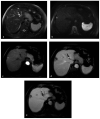Imaging Diagnosis of Hepatocellular Carcinoma: A State-of-the-Art Review
- PMID: 36832113
- PMCID: PMC9955560
- DOI: 10.3390/diagnostics13040625
Imaging Diagnosis of Hepatocellular Carcinoma: A State-of-the-Art Review
Abstract
Hepatocellular carcinoma (HCC) remains not only a cause of a considerable part of oncologic mortality, but also a diagnostic and therapeutic challenge for healthcare systems worldwide. Early detection of the disease and consequential adequate therapy are imperative to increase patients' quality of life and survival. Imaging plays, therefore, a crucial role in the surveillance of patients at risk, the detection and diagnosis of HCC nodules, as well as in the follow-up post-treatment. The unique imaging characteristics of HCC lesions, deriving mainly from the assessment of their vascularity on contrast-enhanced computed tomography (CT), magnetic resonance (MR) or contrast-enhanced ultrasound (CEUS), allow for a more accurate, noninvasive diagnosis and staging. The role of imaging in the management of HCC has further expanded beyond the plain confirmation of a suspected diagnosis due to the introduction of ultrasound and hepatobiliary MRI contrast agents, which allow for the detection of hepatocarcinogenesis even at an early stage. Moreover, the recent technological advancements in artificial intelligence (AI) in radiology contribute an important tool for the diagnostic prediction, prognosis and evaluation of treatment response in the clinical course of the disease. This review presents current imaging modalities and their central role in the management of patients at risk and with HCC.
Keywords: artificial intelligence; computed tomography; hepatocellular carcinoma; magnetic resonance imaging; ultrasound.
Conflict of interest statement
The authors declare no conflict of interest.
Figures



Similar articles
-
Recent Advances in CT and MR Imaging for Evaluation of Hepatocellular Carcinoma.Liver Cancer. 2012 Jun;1(1):22-40. doi: 10.1159/000339018. Liver Cancer. 2012. PMID: 24159569 Free PMC article. Review.
-
Noninvasive imaging of hepatocellular carcinoma: From diagnosis to prognosis.World J Gastroenterol. 2018 Jun 14;24(22):2348-2362. doi: 10.3748/wjg.v24.i22.2348. World J Gastroenterol. 2018. PMID: 29904242 Free PMC article. Review.
-
Irreversible electroporation of hepatocellular carcinoma: preliminary report on the diagnostic accuracy of magnetic resonance, computer tomography, and contrast-enhanced ultrasound in evaluation of the ablated area.Radiol Med. 2016 Feb;121(2):122-31. doi: 10.1007/s11547-015-0582-5. Epub 2015 Sep 7. Radiol Med. 2016. PMID: 26345332
-
Contrast-enhanced ultrasound: Improving the preoperative staging of hepatocellular carcinoma and guiding individual treatment.World J Gastroenterol. 2014 Sep 21;20(35):12628-36. doi: 10.3748/wjg.v20.i35.12628. World J Gastroenterol. 2014. PMID: 25253968 Free PMC article.
-
Current Imaging Diagnosis of Hepatocellular Carcinoma.Cancers (Basel). 2022 Aug 18;14(16):3997. doi: 10.3390/cancers14163997. Cancers (Basel). 2022. PMID: 36010991 Free PMC article. Review.
Cited by
-
Decoding the Role of O-GlcNAcylation in Hepatocellular Carcinoma.Biomolecules. 2024 Jul 25;14(8):908. doi: 10.3390/biom14080908. Biomolecules. 2024. PMID: 39199296 Free PMC article. Review.
-
Delta-radiomics in cancer immunotherapy response prediction: A systematic review.Eur J Radiol Open. 2023 Jul 18;11:100511. doi: 10.1016/j.ejro.2023.100511. eCollection 2023 Dec. Eur J Radiol Open. 2023. PMID: 37520768 Free PMC article.
-
Biosensing of Alpha-Fetoprotein: A Key Direction toward the Early Detection and Management of Hepatocellular Carcinoma.Biosensors (Basel). 2024 May 8;14(5):235. doi: 10.3390/bios14050235. Biosensors (Basel). 2024. PMID: 38785709 Free PMC article. Review.
-
Radiomics-Based Classification of Tumor and Healthy Liver on Computed Tomography Images.Cancers (Basel). 2024 Mar 14;16(6):1158. doi: 10.3390/cancers16061158. Cancers (Basel). 2024. PMID: 38539493 Free PMC article.
-
Targeting Glypican-3 in Liver Cancer: Groundbreaking Preclinical and Clinical Insights.Biomedicines. 2025 Jun 26;13(7):1570. doi: 10.3390/biomedicines13071570. Biomedicines. 2025. PMID: 40722645 Free PMC article. Review.
References
-
- Alberts C.J., Clifford G.M., Georges D., Negro F., Lesi O.A., Hutin Y.J.-F., de Martel C. Worldwide prevalence of hepatitis B virus and hepatitis C virus among patients with cirrhosis at country, region, and global levels: A systematic review. Lancet Gastroenterol. Hepatol. 2022;7:724–735. doi: 10.1016/s2468-1253(22)00050-4. - DOI - PMC - PubMed
-
- Onzi G., Moretti F., Balbinot S.S., Balbinot R.A., Soldera J. Hepatocellular carcinoma in non-alcoholic fatty liver disease with and without cirrhosis. Hepatoma Res. 2019;2019 doi: 10.20517/2394-5079.2018.114. - DOI
Publication types
LinkOut - more resources
Full Text Sources

